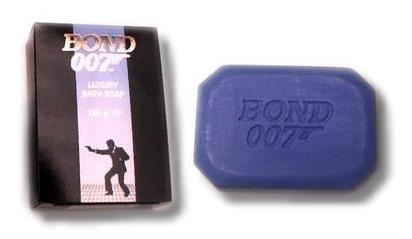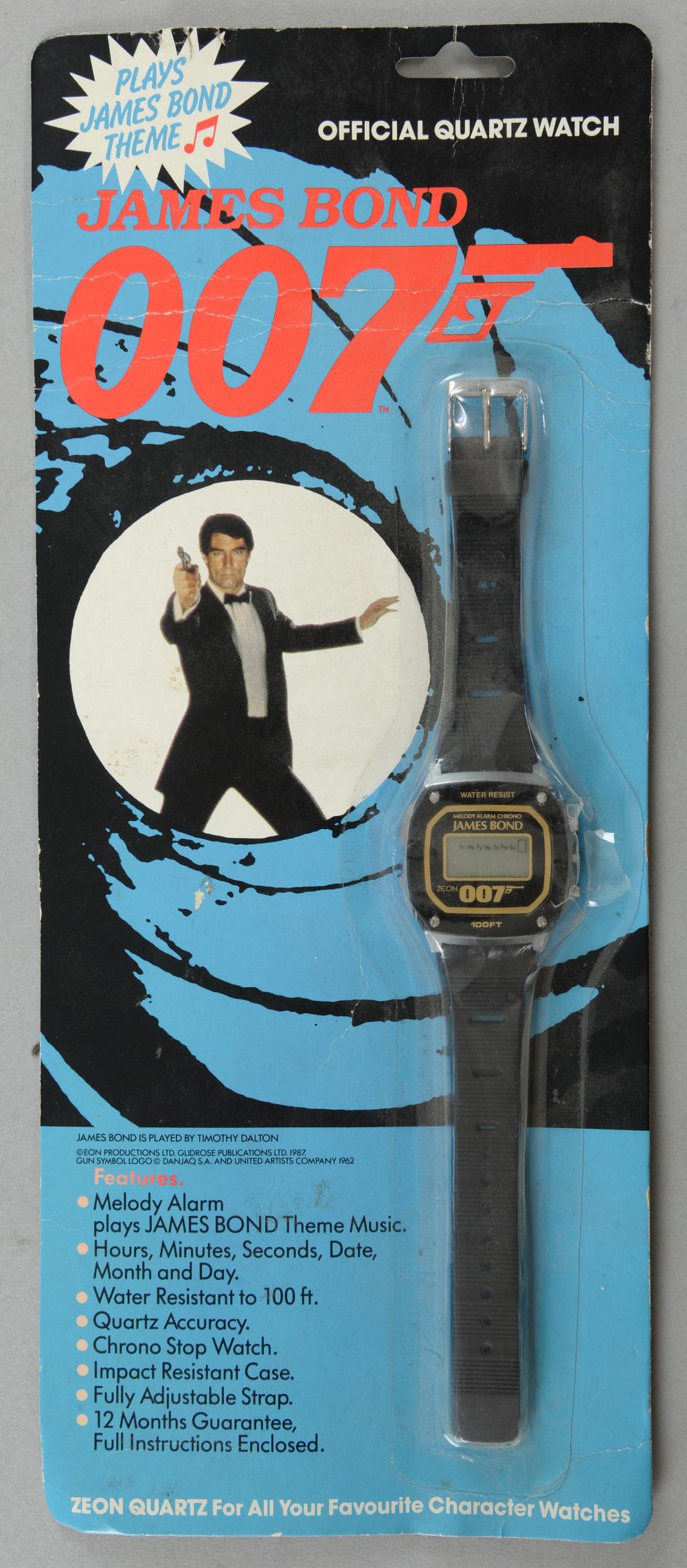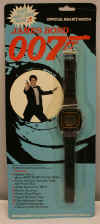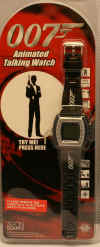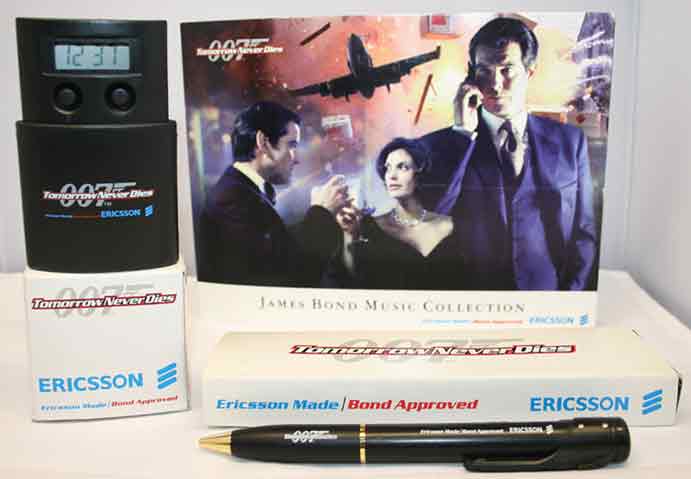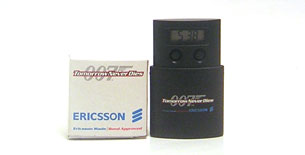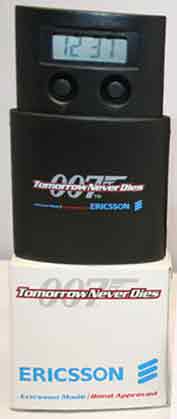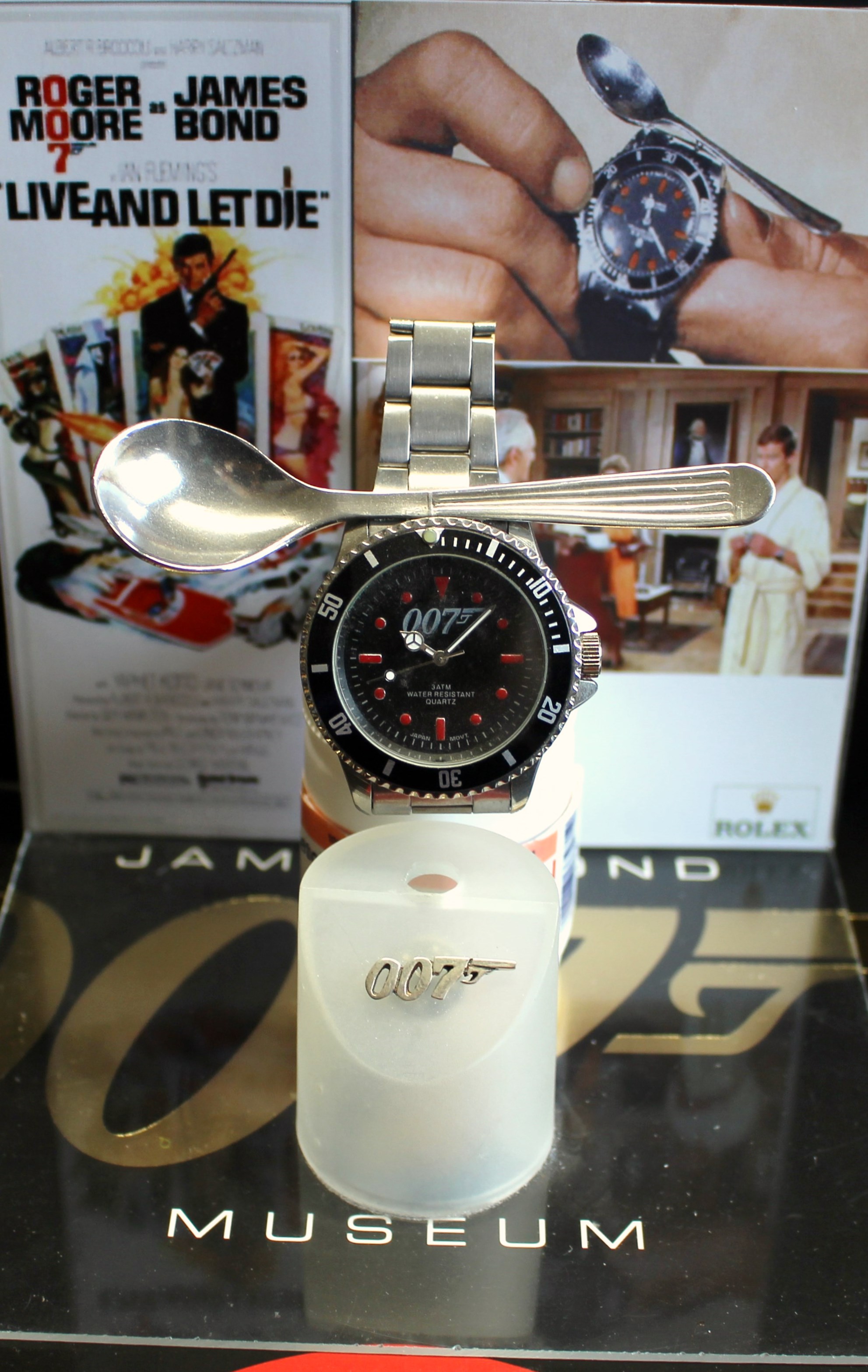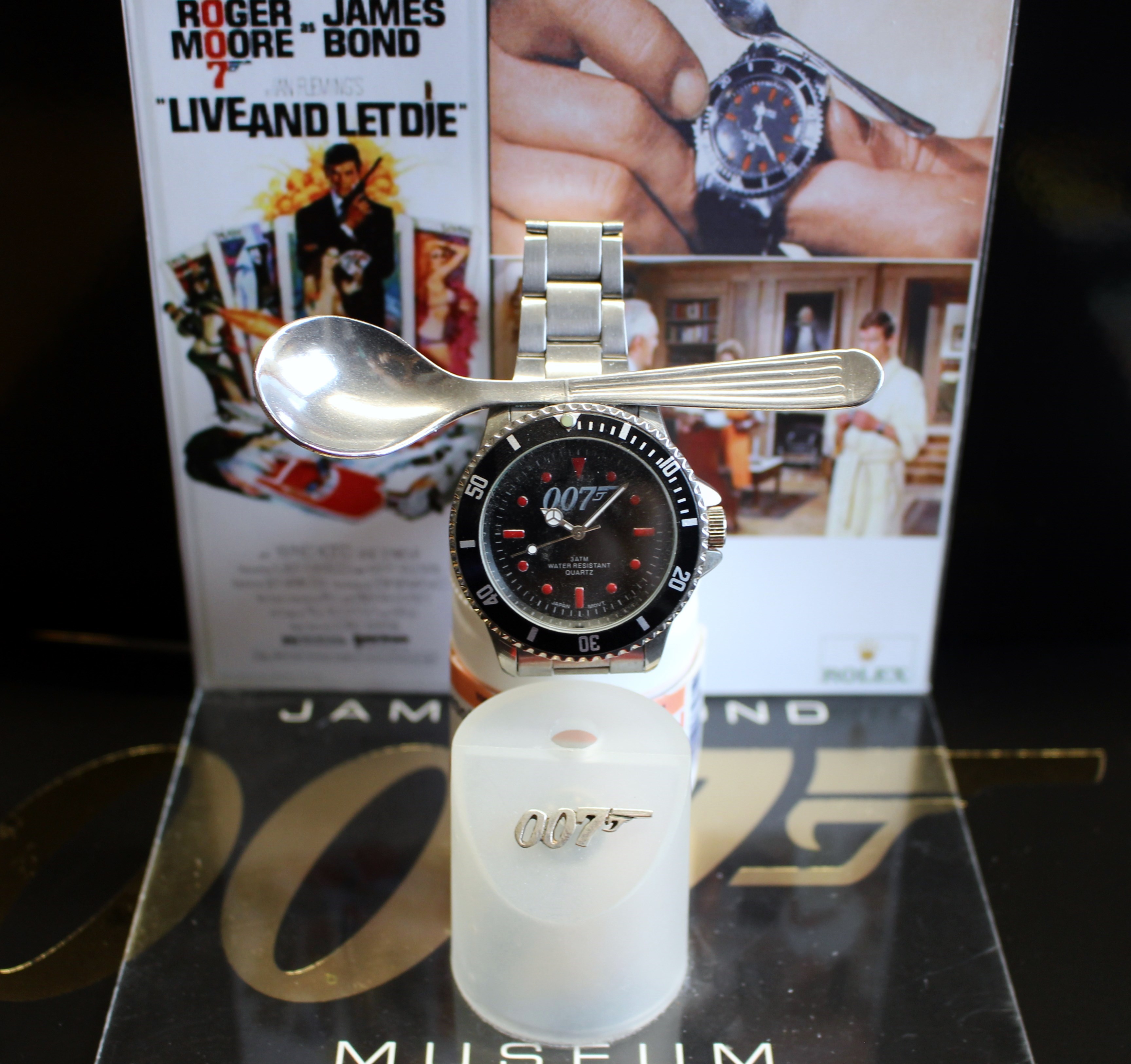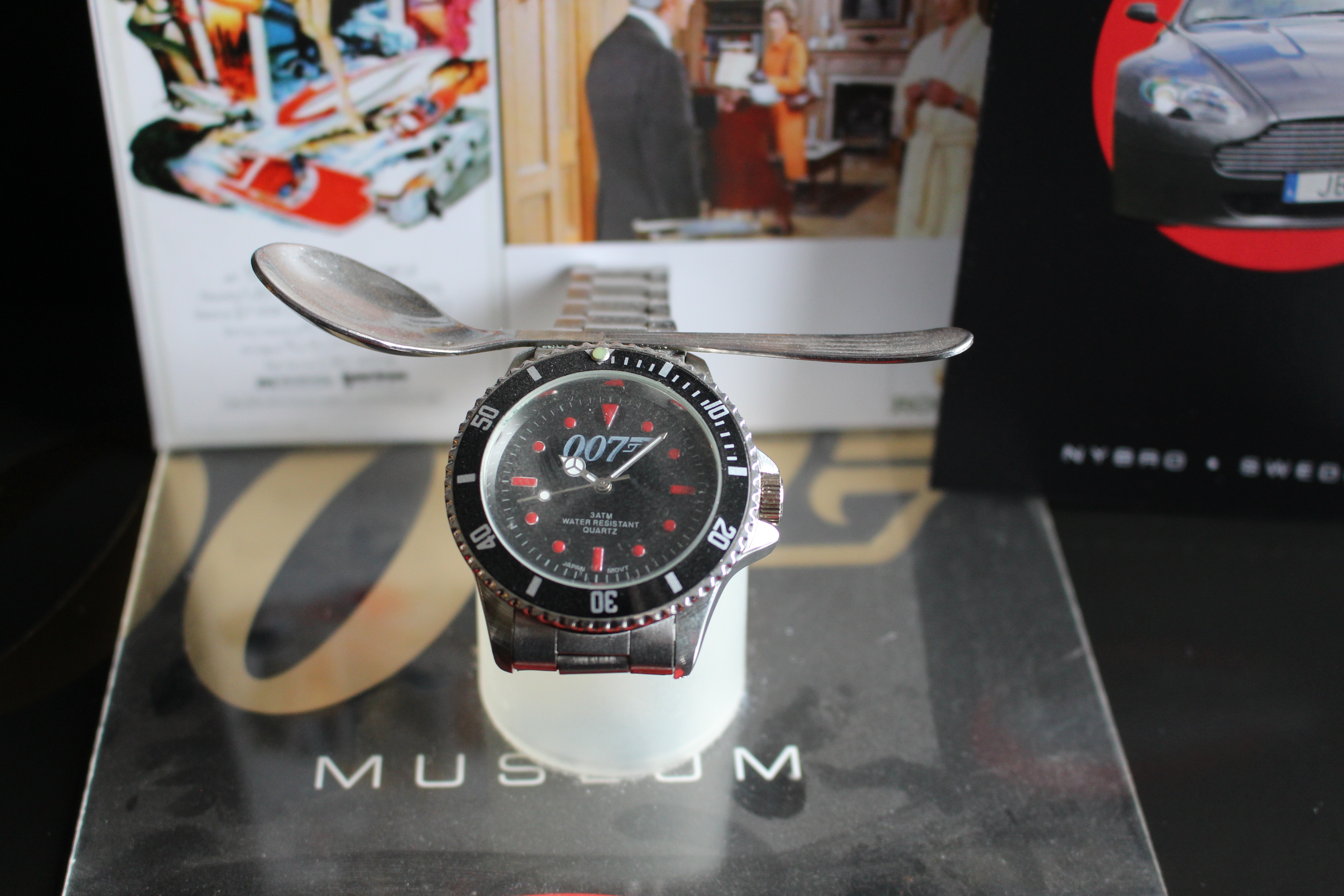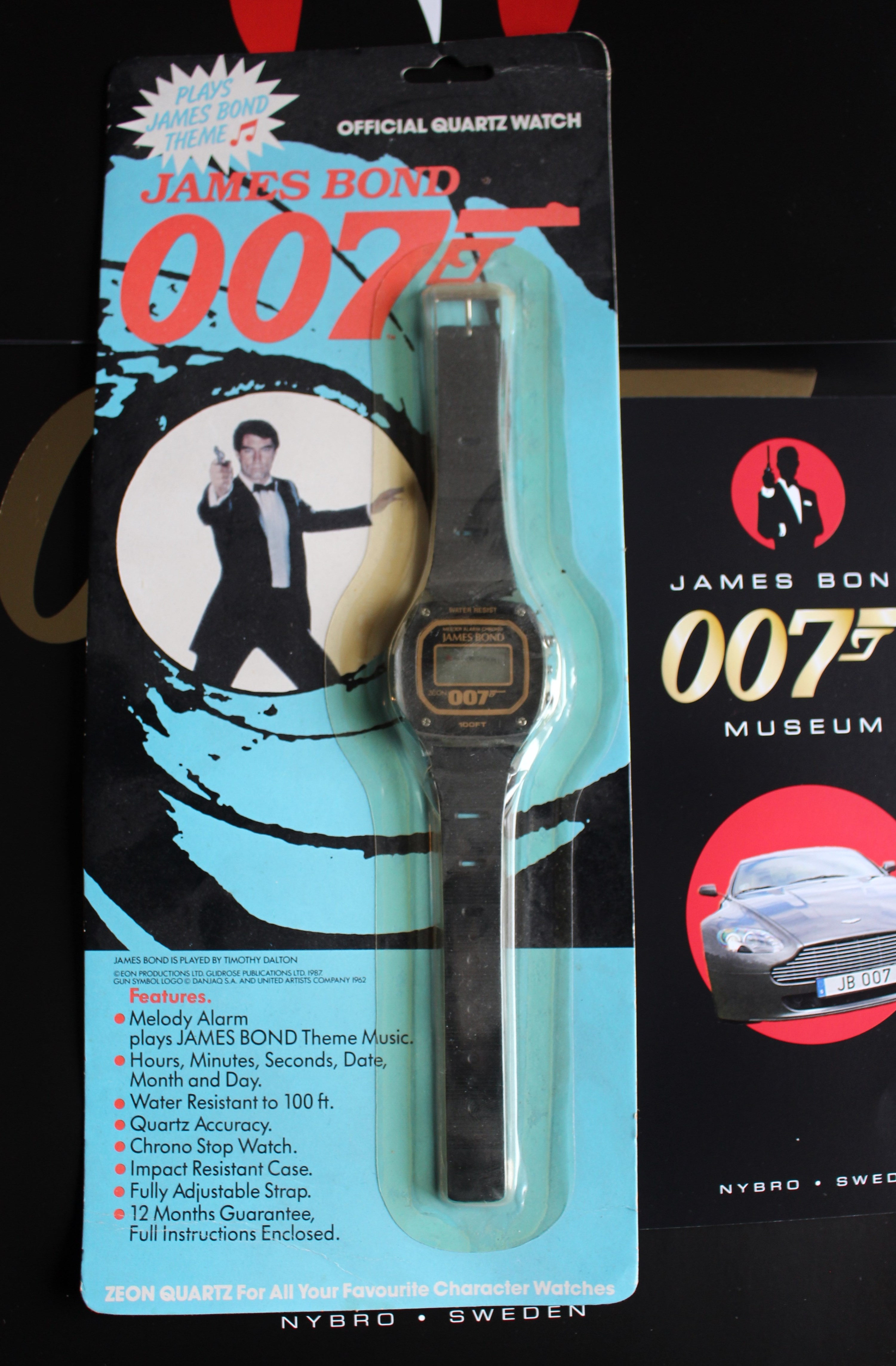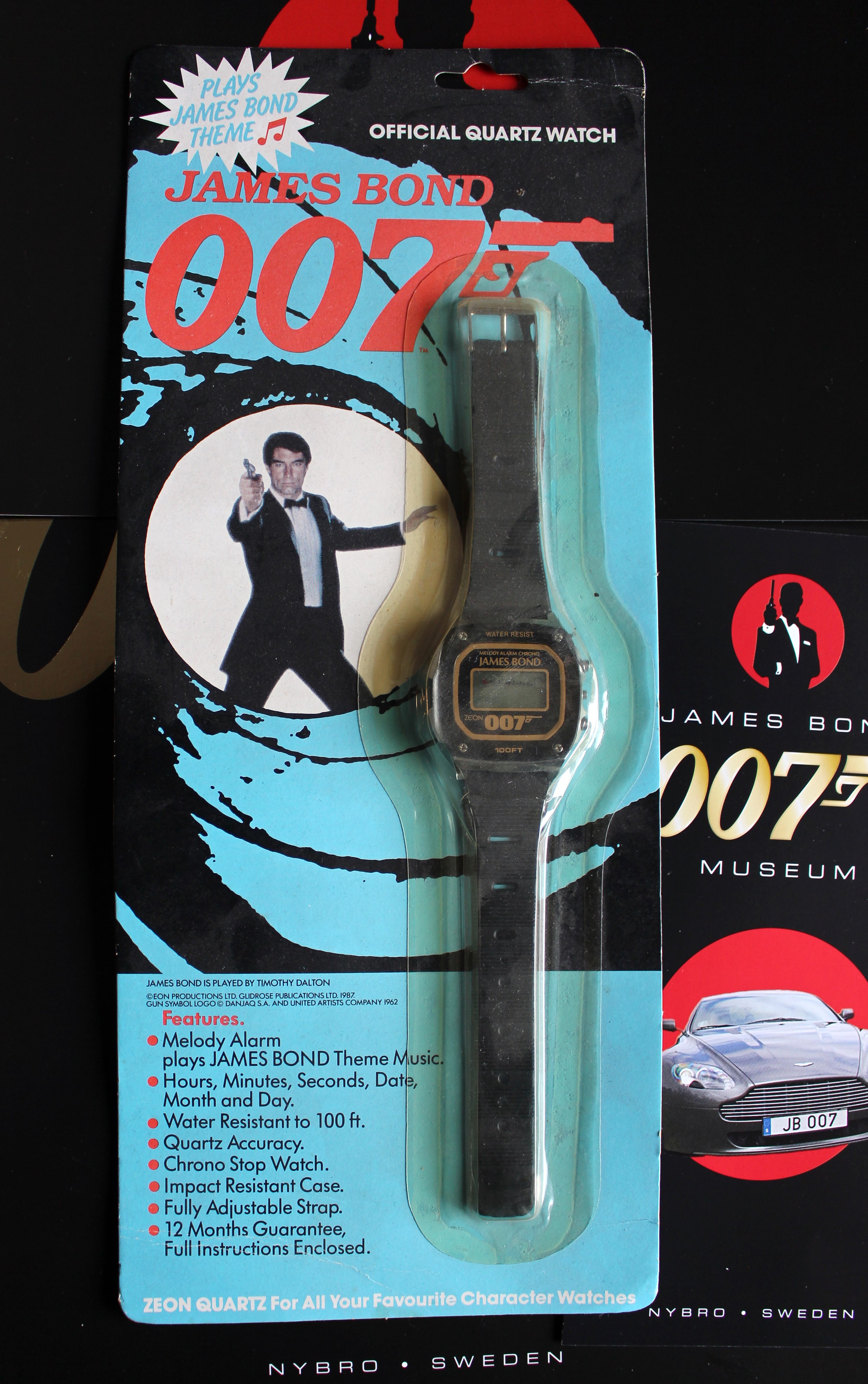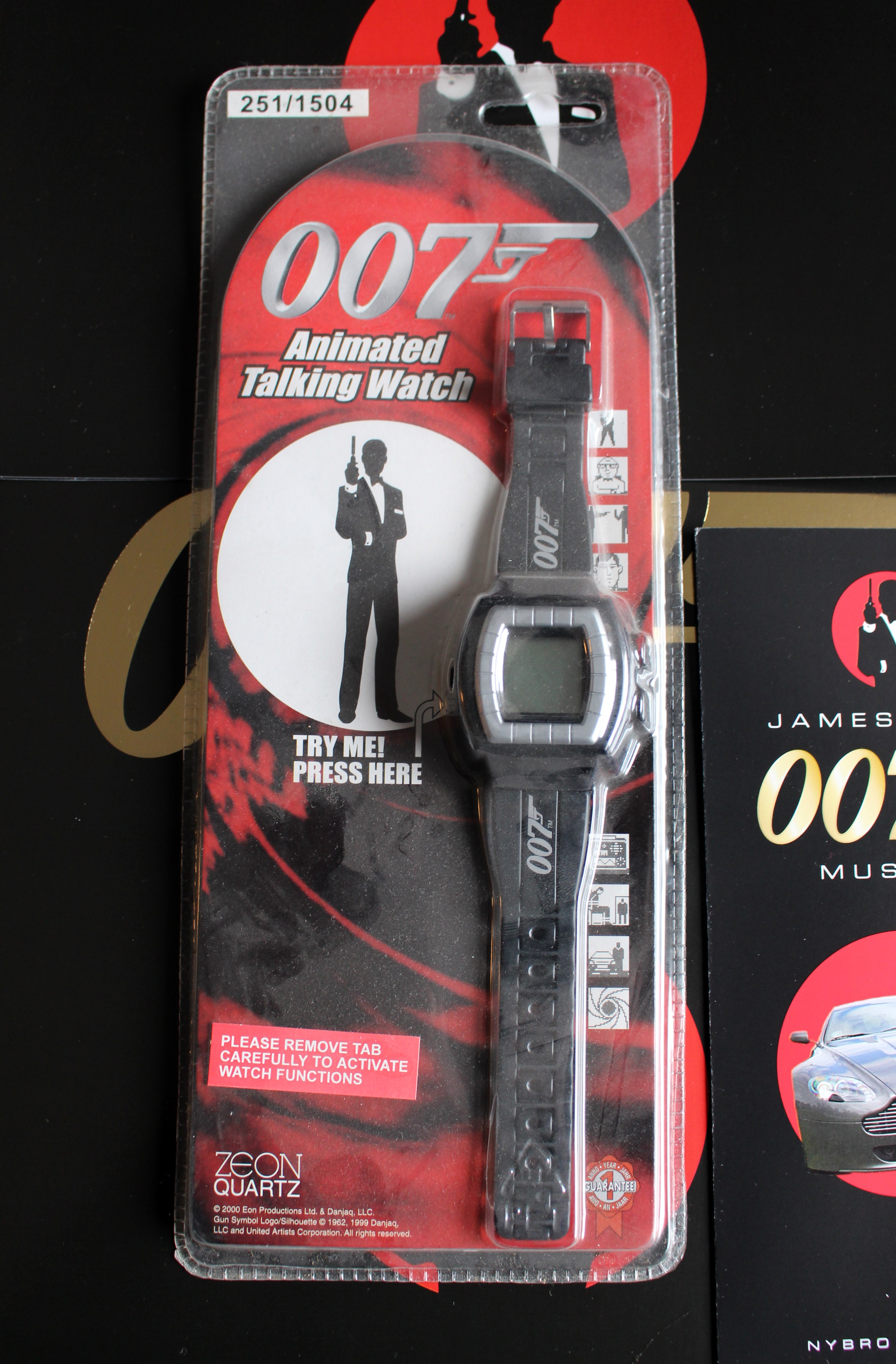|
So you can be sure that it is not without good reason that some of the
world's finest watchmakers (among them such heavyweights as Rolex, Omega,
and Seiko) have sought to link their products to the excitement, elegance
and cachet that the public has learned to associate with James Bond, the
gentleman secret agent with a licence to kill. Most recently it's been
Omega that has been peppering magazines and newspapers around the world
with images of James Bond wearing their "Seamaster Professional"
model with the legend "Selected by James Bond." Note that this
is not an endorsement by Pierce Brosnan, but rather by James Bond. Despite
what 007 told Fatima Blush in NEVER SAY NEVER AGAIN,
 Naturally, it was Ian
Fleming who started it all. He knew that a gentleman's choice of timepiece
says as much about him as does his Saville Row suit. He took the time to
specify Bond's choice. According to Fleming, and he should know, Bond
wears a Rolex Oyster Perpetual Chronometer on an expanding metal bracelet.
He tells us so in chapter 15 of On Her Majesty's Secret Service .
Naturally, it was Ian
Fleming who started it all. He knew that a gentleman's choice of timepiece
says as much about him as does his Saville Row suit. He took the time to
specify Bond's choice. According to Fleming, and he should know, Bond
wears a Rolex Oyster Perpetual Chronometer on an expanding metal bracelet.
He tells us so in chapter 15 of On Her Majesty's Secret Service .
The good people at Rolex would surely have been surprised by Bond's
jury-rigged use of his Oyster Perpetual as a knuckle-duster. In chapter 16
of OHMSS Bond switches his watch to his right hand and loops the band
around his fist so that the heavy metal and crystal watchcase sits atop
his middle knuckles. The metal watch bracelet is clutched in his palm.
Just minutes later Bond makes use of this improvised "Q" device
when he kills a guard by punching him so hard that the Rolex's crystal
shatters against his jaw.
But Bond seldom needs to exercise his creativity. "Q" always
crafts a deathray or miniaturized howitzer, or some such, into an
ostensibly innocuous object. That is never truer than when the subject is
a wristwatch. They have frequently been the means by which some incredible
device has been concealed.
Unfortunately, The British Secret Service doesn't hold a monopoly on
the idea, and Bond has occasionally found himself on the wrong end of a
tricky timepiece's treachery.
In fact, it was S.P.E.C.T.R.E. that showed the movie going public the
very first two-timing timepiece. Übermensch Red Grant was seen in
the pre-credits sequence of FROM RUSSIA WITH LOVE, dealing an untimely
death to a Bond look-a-like by means of a wristwatch that featured a
garrote wire coiled inside.
When unspooled to full length  by
pulling on the stem, it could be looped around the hapless victim's throat.
It worked fine in rehearsal, but when Grant tried it on the real James
Bond it was Grant who wound up wearing the garrote. by
pulling on the stem, it could be looped around the hapless victim's throat.
It worked fine in rehearsal, but when Grant tried it on the real James
Bond it was Grant who wound up wearing the garrote.
After this rather promising start, the opposition's creativity with
clocks waned somewhat. GOLDFINGER was the first "gadget
intensive" double-oh seven film, though certainly not the last or
least. But the best trick timepiece the opposition could muster was just a
wall clock with a peephole that allowed Mai Ling to keep tabs on Bond
aboard Goldfinger s private jet. It didn't fool Bond who easily thwarted
it by the simple expedient of hanging his coat over it. Score: Bond 1,
Goldfinger 0.
GOLDFINGER was the third film in the series, and although Bond had been
shown to wear a Rolex, there had been no special gadgets associated with
it yet. In fact, the use of Bond's wristwatches, used so creatively later
in the film series, stumbled badly coming out of the starting block. On
the very first day of filming DR.NO it was discovered the Sean Connery
hadn't been given a Rolex watch to wear. The scene required it, so nothing
more could be done until one could be procured. Director himself a former real-life "James Bond", stepped in
to save the day by lending Connery his own Rolex. Filming proceeded and
the rest, as they say, is cinema history!
Bond's first real chance to show what tricks the good guys had up their
sleeve, both metaphorically and literally, didn't come until THUNDERBALL.
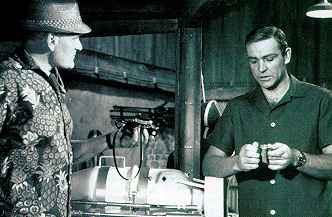
"Q" leaves his workshop to outfit Bond with his latest gear
"in the field". Only "Q" could manage to complain
about a free trip to the Bahamas. He brings with him a watch he describes
as a Rolex, but which doesn't look like any model I ve been able to track
down.
The trick to this watch is that it functions as a Geiger counter. If
you compare this to the Geiger counter issued to 007 in DR.NO you'll see
how far Q-branch have come. Not only does this Geiger counter fit on
Bond's wrist, it also tells time!
With the arrival of Roger Moore came the arrival of the really far out
wristwatch gadgets. One of the wildest was an ordinary looking Rolex in
Moore's debut Bond film, LIVE AND LET DIE.
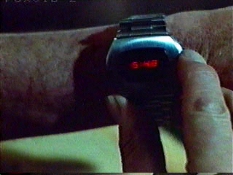 This film is one of
only two Bond films in which Desmond Llewelyn ("Q") fails to
appear. Instead it is Miss Moneypenny who brings Moore his gadget watch.
The film begins with Moore wearing a Pulsar digital watch. This film is one of
only two Bond films in which Desmond Llewelyn ("Q") fails to
appear. Instead it is Miss Moneypenny who brings Moore his gadget watch.
The film begins with Moore wearing a Pulsar digital watch.
This was the very first digital watch on the market. You had to press a
button to activate the glowing red digits. Otherwise you couldn't tell the
time. It was groundbreaking technology at the time and the watch is worth
more to collectors today than it cost new back then.
(A brief aside: The film editor was really on the ball
here. When we see Moore check the time on his Pulsar it reads
"5:48". When we get a close up of a Rolex four minutes later,
the time is "5:52". Four minutes has passed in James Bond's
world, and four minutes has passed in the audience's world, too. They
match up. When you think of all the separately filmed elements that are
edited together to form the final print of the film you can appreciate
that this is the sort of thing that is done wrong 99.9% of the time. This
is that remaining 0.01%. Someone at EON was paying attention and took the
trouble to get this very little detail right!)
The Pulsar Moore wears is replaced just ten minutes into the film by a
Rolex with a couple of way out features:
Moore explains to "M" that pulling the stem on this ordinary
looking Rolex wristwatch, activates a "Hyper intensified magnetic
field" "powerful enough to even deflect the path of a bullet at
long range." But of course Moore uses it, instead, to whisk a spoon
off of "M"s coffee saucer, and later, to unzip a damsel's dress.
Perhaps just as well, after all, that "Q" wasn't in this film to
witness these uses of his hard work!
As a visual cue that the magnetic field is engaged the otherwise white
number markings on the watch turn to red. Given the demonstrated power of
this watch later in the film, a more obvious visual would be the fact that
every metal object within 50ft should be flying though the air and
attaching itself to our hero's wrist! But this doesn't happen, and only
the objects Bond wants to be attracted ever seem to be.
One has to wonder why this "bullet deflecting watch" isn't
issued to Bond on every mission from here on out. There's certainly no
shortage of baddies taking pot shots at our hero. Yet after LIVE AND LET
DIE, this estimable feature is never seen again!
There's an inexplicable continuity error involving this watch. Having
given the audience a visual and verbal description of how to activate the
magnetic field by pulling on the watch stem, the filmmakers proceed
through out the rest of the film to use a completely different method. On
two separate occasions we see Moore, in close up, activating the magnetic
field by turning the watch bezel instead of pulling the stem. Go figure.
You've got to admit, a Hyper intensified Magnetic 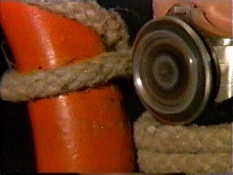 Field
built into a wristwatch is impressive enough, but the good folks at EON
aren't done with this watch yet. Not by half. The top of this watch can be
set spinning so the serrated edge of the bezel acts like a miniature buzz
saw! Field
built into a wristwatch is impressive enough, but the good folks at EON
aren't done with this watch yet. Not by half. The top of this watch can be
set spinning so the serrated edge of the bezel acts like a miniature buzz
saw!
I quite like this gimmick. It's not too complicated and might actually
work. It's certainly a feature that stands Moore in good stead near the
end of the film when he uses it to cut the 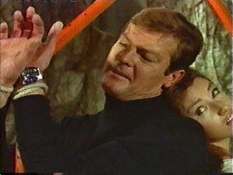 ropes
that secure him to an "unnecessarily slow dipping mechanism" ropes
that secure him to an "unnecessarily slow dipping mechanism"
In THE SPY WHO LOVED ME, Moore's Rolex has been retired in favour of a
Seiko that has no defensive capabilities, but is, instead, a
communications device. It displays messages and is seen to print a
ticker-tape message from "M".
This watch is rather passive compared with the previous Rolex, but in
MOONRAKER the Seiko issued to Moore gets things going again with a bang.
 When Moore faces imminent
death in the blast pit below a Moonraker Space Shuttle about to depart, he
pops open the rear of the watchcase to reveal a tiny coil of explosive
plastique. When Moore faces imminent
death in the blast pit below a Moonraker Space Shuttle about to depart, he
pops open the rear of the watchcase to reveal a tiny coil of explosive
plastique.
He affixes the explosive to the exit 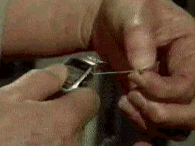 hatch
lock, and then, going back to his watch, pulls out the upper right control
button from the watchcase to produce a long detonator wire. hatch
lock, and then, going back to his watch, pulls out the upper right control
button from the watchcase to produce a long detonator wire.
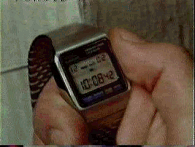 This he plugs this into
the explosive, which he detonates by pushing on the right side of the
watchcase. This he plugs this into
the explosive, which he detonates by pushing on the right side of the
watchcase.
All these tiny pieces are very nicely made, and are crafted with
excellent detail. The explosive coil even has a tiny metal receptacle at
the center where the detonator wire plugs in. It's a nice looking piece of
work by the Effects crew.
There are redeeming touches in MOONRAKER despite the fact that it is
often at the bottom of people's list of favorite Bond films. This scene in
the blast pit is one of them because it's a carry- over from Fleming's
novel. The situation above is a somewhat morphed, but still recognizable
version of the situation that Bond and the heroine (in the novel it's Gala
Brand) find themselves in. They are left to die in a room that is open
onto the blast pit of the Moonraker missile. In the novel, their means of
escape is different, but the initial situation is the same. It is always a
pleasure to see some of Fleming's material translated to film and so it
deserves a mention here.
FOR YOUR EYES ONLYsees a return to Bond's watch being merely a communications device, and not a weapon of
any kind. Moore is still wearing a Seiko. This one allows for a digital
message to scroll across the top of the watchface, and also for audible
communication similar to Dick Tracy's two-way-wrist-radio. Here the
features are used purely for gag value at the end of the film. But for me
the real entertainment of the scene comes from catching two goofs.
to Bond's watch being merely a communications device, and not a weapon of
any kind. Moore is still wearing a Seiko. This one allows for a digital
message to scroll across the top of the watchface, and also for audible
communication similar to Dick Tracy's two-way-wrist-radio. Here the
features are used purely for gag value at the end of the film. But for me
the real entertainment of the scene comes from catching two goofs.
First, when Moore places the watch on the parrot-stand, the watchband
is fully open. But when the parrot tosses the watch into the water and we
see it drifting to the bottom, the watchband has mysteriously closed
itself. The second goof is a very clearly visible "invisible"
nylon filament line attached to the descending watch in the scene.
(Don't get me wrong. I don't point these out as criticism. I find
these newly given up little "secrets" actually endear the films
to me all the more. I know the films weren t meant to be scrutinized with
freeze frame off a laser disc on a 32" TV set like I do, but I enjoy
finding new little quirks like these.)
The films seem almost to alternate the functions of Bond's wristwatch.
One time the watch is passive (communications, Geiger counter, homing
device), and the next time it is aggressive (laser beam, buzz saw,
explosive), and then back again to passive, and so on.
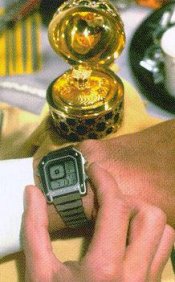 So it's unusual that after
the passive functions of 007's watch in FYEO, that the watch in OCTOPUSSY
should also be passive. The feature this time around is that the watch
monitors the tiny homing transmitter placed into the imitation Faberge egg
that Moore allows Magda to steal (after sleeping with her first, of course). So it's unusual that after
the passive functions of 007's watch in FYEO, that the watch in OCTOPUSSY
should also be passive. The feature this time around is that the watch
monitors the tiny homing transmitter placed into the imitation Faberge egg
that Moore allows Magda to steal (after sleeping with her first, of course).
The egg is also wired for sound, and sends its signals to double-oh
seven's special Mont Blanc fountain pen.
In 1983 Bond fans were doubly blessed.
While Moore was running through the jungles of India, Sean Connery had
donned his 007 livery once again to star in the only serious non-EON James
Bond production, NEVER SAY NEVER AGAIN. Q is here (Alec McCowen). Humour
is still a part of his scene, and a wristwatch is still part of the
equipment he issues to Bond. We see this when Bond uses a concealed laser
beam to cut himself free from a set of manacles. In a unique twist, the
gadget is not contained in the watch itself, but in the clasp of the
watchband!
Timothy Dalton got to play with only a trick timepiece, but it wasn't a
wristwatch. In LICENCE TO KILL, Q gives Bond an assortment of items, which
include an exploding alarm clock. Unfortunately for us, Bond never gets a
chance to use it.
In GOLDENEYE, Pierce Brosnan's 007 debut, he was issued an Omega
Seamaster Professional with two, count 'em, two special devices.
 While locked within a
Russian military train, Natalya Simonova impatiently commands Bond, "Don'
t just stand there, get us OUT of here!" He obeys her edict by
using his Omega's built in laser beam to cut a hole through the floor. While locked within a
Russian military train, Natalya Simonova impatiently commands Bond, "Don'
t just stand there, get us OUT of here!" He obeys her edict by
using his Omega's built in laser beam to cut a hole through the floor.
The feature is similar to the one in NEVER SAY NEVER AGAIN, but with
two exceptions: 1) The laser comes out of the watch itself instead of the
out of the watch strap buckle. And, 2) this is a much classier looking
wristwatch by far!
The second Omega feature shown actually works against Bond.  When
Alec Trevelyan examines Bond's personal effects after having captured him,
he recognizes several familiar items. In fact, he actually inquires after
"good old Q." Trevelyan still wears his own, service issue,
Omega Seamaster Professional, and compares Bond's "new model"
against his own. When
Alec Trevelyan examines Bond's personal effects after having captured him,
he recognizes several familiar items. In fact, he actually inquires after
"good old Q." Trevelyan still wears his own, service issue,
Omega Seamaster Professional, and compares Bond's "new model"
against his own.
"Do I still press here?" he inquires. Suiting action to the
word, Trevelyan unwittingly does himself a good turn. Pressing the button
shuts off the countdown on the explosive device which Bond had recently
rigged.
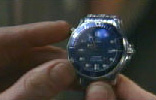 Fortunately for Bond,
England, the world, Fortunately for Bond,
England, the world,  and
film-going audiences everywhere, Bond's sporting a Q-device too new for
Trevelyan to know about: an exploding pen. Supergeek Boris Grishenko
obligingly activates it and initiates what is by now virtually mandatory
in a James Bond film: the explosive destruction of the villain's HQ. and
film-going audiences everywhere, Bond's sporting a Q-device too new for
Trevelyan to know about: an exploding pen. Supergeek Boris Grishenko
obligingly activates it and initiates what is by now virtually mandatory
in a James Bond film: the explosive destruction of the villain's HQ.
In TOMORROW NEVER DIES the hidden gadget in the Omega has changed yet
again. We have to wait almost until the end of the film to see it.
A small piece is made to be separated from the watch  and
activated remotely via radio signal from the parent unit. Bond uses his
own native cunning to make this feature work for him even better than
designed by Q. and
activated remotely via radio signal from the parent unit. Bond uses his
own native cunning to make this feature work for him even better than
designed by Q.
First, he attaches the tiny remote unit with a micro explosive to the
side of an ordinary glass jar. Next he pulls the pin off a "lemon"
grenade so that the only thing keeping the grenade from exploding is the
spring-loaded "spoon" still attached to the grenade. Holding the
grenade carefully, Bond slips it into the jar so that the spoon is held in
place.
Later, when needed, Bond uses his Omega to send a signal to receiver
attached to the side of the glass jar which sets off the micro-explosive,
shattering the jar, releasing the spring-loaded spoon and allowing the
grenade to go BOOM! It s'a sequence that would make Rube Goldberg proud!
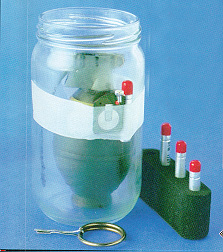 I'm especially fond of
this scene because it allows Bond to use his own wits instead of just
activating one of Q's inventions. We still get the fun "Q-device",
but not at the expense of Bond taking a back seat to the gadget. That had
usually been the case during the Moore era when gadgets were king. I'm especially fond of
this scene because it allows Bond to use his own wits instead of just
activating one of Q's inventions. We still get the fun "Q-device",
but not at the expense of Bond taking a back seat to the gadget. That had
usually been the case during the Moore era when gadgets were king.
In TND Brosnan s Bond is allowed to show his own creativity and
improvisation. It s a link back to that scene long ago in Ian Fleming s
novel OHMSS when Bond improvised a knuckle-duster using his Rolex.
That's one of the things I like so much about the Brosnan Bond. Bond is
totally up to date, but with strong, recognizable links to his early days.
It s a delicate balancing act to pull off, but one that EON is achieving
masterfully.
So, (to overwork an analogy) just like the hands of a wristwatch moving
always forward only to return to where they began, in the end, with the
Brosnan Bond, we come full circle. As the song says, " Everything old
is new again."
From the earliest days through to the most modern Bond film,
wristwatches have been featured prominently. They ve been used as a weapon,
as a means for escape, as a way to get and send messages. They've been the
focus for comedy, and simply as an element of that famous "Double-Oh
Seven" style.
|
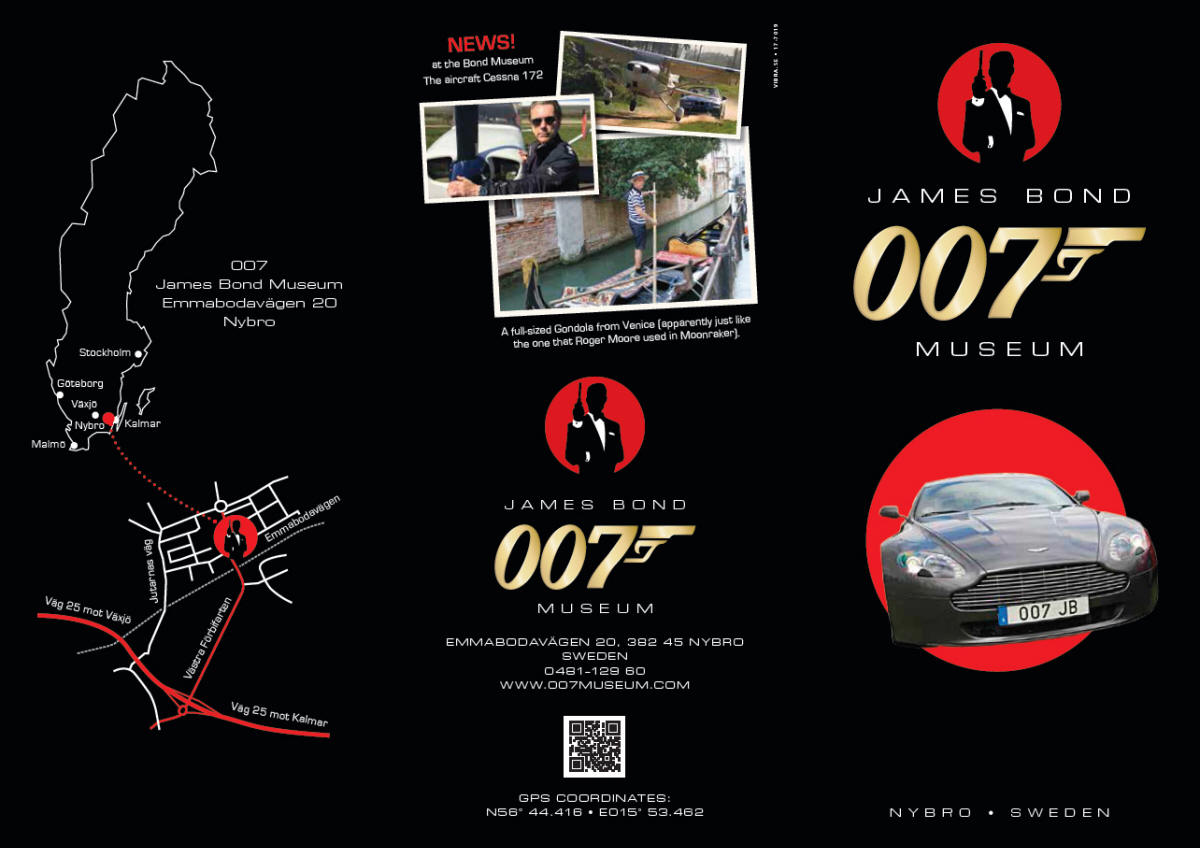














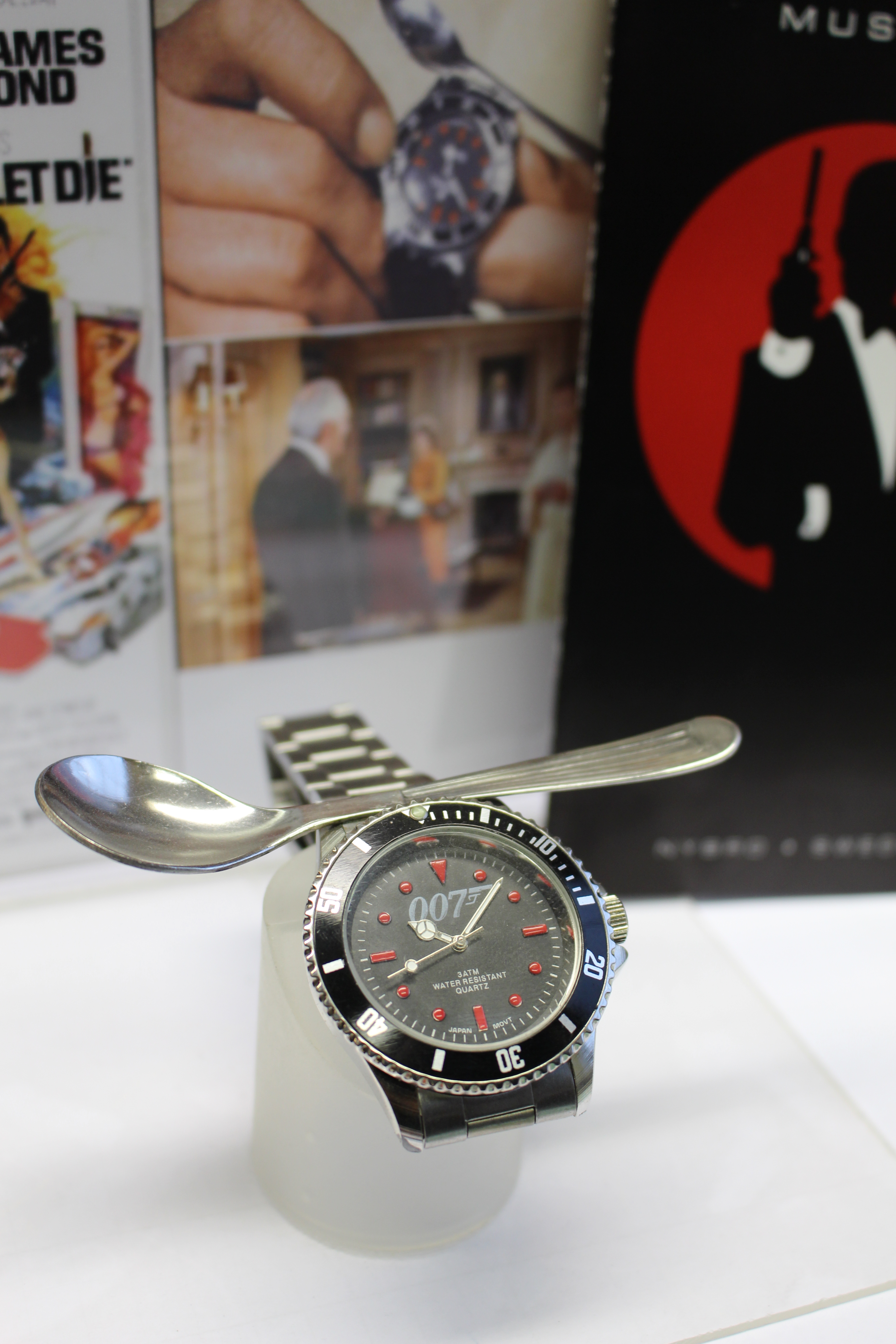


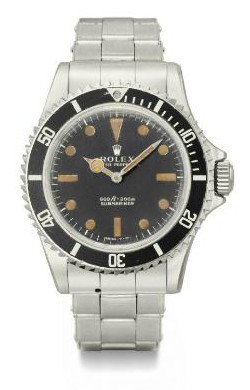
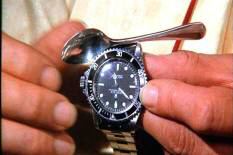
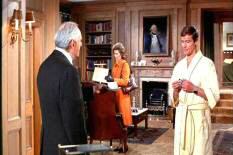
 Naturally, it was Ian
Fleming who started it all. He knew that a gentleman's choice of timepiece
says as much about him as does his Saville Row suit. He took the time to
specify Bond's choice. According to Fleming, and he should know, Bond
wears a Rolex Oyster Perpetual Chronometer on an expanding metal bracelet.
He tells us so in chapter 15 of On Her Majesty's Secret Service .
Naturally, it was Ian
Fleming who started it all. He knew that a gentleman's choice of timepiece
says as much about him as does his Saville Row suit. He took the time to
specify Bond's choice. According to Fleming, and he should know, Bond
wears a Rolex Oyster Perpetual Chronometer on an expanding metal bracelet.
He tells us so in chapter 15 of On Her Majesty's Secret Service .
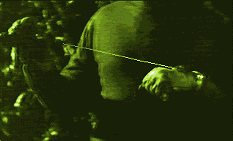
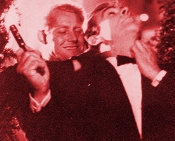
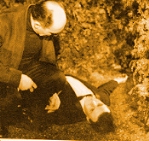
 by
pulling on the stem, it could be looped around the hapless victim's throat.
It worked fine in rehearsal, but when Grant tried it on the real James
Bond it was Grant who wound up wearing the garrote.
by
pulling on the stem, it could be looped around the hapless victim's throat.
It worked fine in rehearsal, but when Grant tried it on the real James
Bond it was Grant who wound up wearing the garrote.

 This film is one of
only two Bond films in which Desmond Llewelyn ("Q") fails to
appear. Instead it is Miss Moneypenny who brings Moore his gadget watch.
The film begins with Moore wearing a Pulsar digital watch.
This film is one of
only two Bond films in which Desmond Llewelyn ("Q") fails to
appear. Instead it is Miss Moneypenny who brings Moore his gadget watch.
The film begins with Moore wearing a Pulsar digital watch.
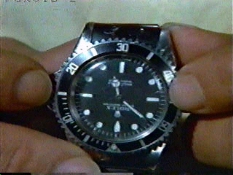

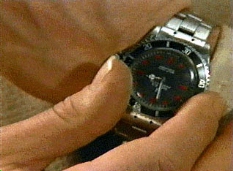
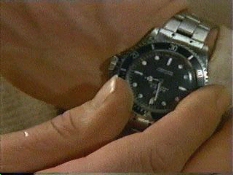
 Field
built into a wristwatch is impressive enough, but the good folks at EON
aren't done with this watch yet. Not by half. The top of this watch can be
set spinning so the serrated edge of the bezel acts like a miniature buzz
saw!
Field
built into a wristwatch is impressive enough, but the good folks at EON
aren't done with this watch yet. Not by half. The top of this watch can be
set spinning so the serrated edge of the bezel acts like a miniature buzz
saw!
 ropes
that secure him to an "unnecessarily slow dipping mechanism"
ropes
that secure him to an "unnecessarily slow dipping mechanism"
 When Moore faces imminent
death in the blast pit below a Moonraker Space Shuttle about to depart, he
pops open the rear of the watchcase to reveal a tiny coil of explosive
plastique.
When Moore faces imminent
death in the blast pit below a Moonraker Space Shuttle about to depart, he
pops open the rear of the watchcase to reveal a tiny coil of explosive
plastique.
 hatch
lock, and then, going back to his watch, pulls out the upper right control
button from the watchcase to produce a long detonator wire.
hatch
lock, and then, going back to his watch, pulls out the upper right control
button from the watchcase to produce a long detonator wire.
 This he plugs this into
the explosive, which he detonates by pushing on the right side of the
watchcase.
This he plugs this into
the explosive, which he detonates by pushing on the right side of the
watchcase.
 to Bond's watch being merely a communications device, and not a weapon of
any kind. Moore is still wearing a Seiko. This one allows for a digital
message to scroll across the top of the watchface, and also for audible
communication similar to Dick Tracy's two-way-wrist-radio. Here the
features are used purely for gag value at the end of the film. But for me
the real entertainment of the scene comes from catching two goofs.
to Bond's watch being merely a communications device, and not a weapon of
any kind. Moore is still wearing a Seiko. This one allows for a digital
message to scroll across the top of the watchface, and also for audible
communication similar to Dick Tracy's two-way-wrist-radio. Here the
features are used purely for gag value at the end of the film. But for me
the real entertainment of the scene comes from catching two goofs.
 So it's unusual that after
the passive functions of 007's watch in FYEO, that the watch in OCTOPUSSY
should also be passive. The feature this time around is that the watch
monitors the tiny homing transmitter placed into the imitation Faberge egg
that Moore allows Magda to steal (after sleeping with her first, of course).
So it's unusual that after
the passive functions of 007's watch in FYEO, that the watch in OCTOPUSSY
should also be passive. The feature this time around is that the watch
monitors the tiny homing transmitter placed into the imitation Faberge egg
that Moore allows Magda to steal (after sleeping with her first, of course).
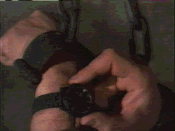
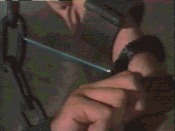
 While locked within a
Russian military train, Natalya Simonova impatiently commands Bond, "Don'
t just stand there, get us OUT of here!" He obeys her edict by
using his Omega's built in laser beam to cut a hole through the floor.
While locked within a
Russian military train, Natalya Simonova impatiently commands Bond, "Don'
t just stand there, get us OUT of here!" He obeys her edict by
using his Omega's built in laser beam to cut a hole through the floor.
 When
Alec Trevelyan examines Bond's personal effects after having captured him,
he recognizes several familiar items. In fact, he actually inquires after
"good old Q." Trevelyan still wears his own, service issue,
Omega Seamaster Professional, and compares Bond's "new model"
against his own.
When
Alec Trevelyan examines Bond's personal effects after having captured him,
he recognizes several familiar items. In fact, he actually inquires after
"good old Q." Trevelyan still wears his own, service issue,
Omega Seamaster Professional, and compares Bond's "new model"
against his own.
 Fortunately for Bond,
England, the world,
Fortunately for Bond,
England, the world,  and
film-going audiences everywhere, Bond's sporting a Q-device too new for
Trevelyan to know about: an exploding pen. Supergeek Boris Grishenko
obligingly activates it and initiates what is by now virtually mandatory
in a James Bond film: the explosive destruction of the villain's HQ.
and
film-going audiences everywhere, Bond's sporting a Q-device too new for
Trevelyan to know about: an exploding pen. Supergeek Boris Grishenko
obligingly activates it and initiates what is by now virtually mandatory
in a James Bond film: the explosive destruction of the villain's HQ.
 and
activated remotely via radio signal from the parent unit. Bond uses his
own native cunning to make this feature work for him even better than
designed by Q.
and
activated remotely via radio signal from the parent unit. Bond uses his
own native cunning to make this feature work for him even better than
designed by Q.
 I'm especially fond of
this scene because it allows Bond to use his own wits instead of just
activating one of Q's inventions. We still get the fun "Q-device",
but not at the expense of Bond taking a back seat to the gadget. That had
usually been the case during the Moore era when gadgets were king.
I'm especially fond of
this scene because it allows Bond to use his own wits instead of just
activating one of Q's inventions. We still get the fun "Q-device",
but not at the expense of Bond taking a back seat to the gadget. That had
usually been the case during the Moore era when gadgets were king.
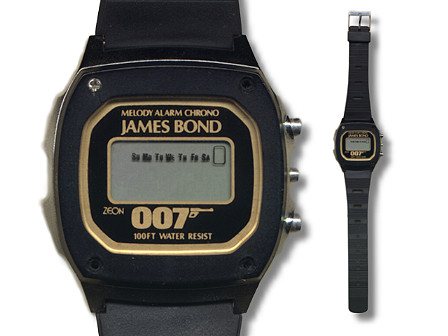 Zeon
'James Bond 007' Melody Alarm Watch (1985)
Zeon
'James Bond 007' Melody Alarm Watch (1985)